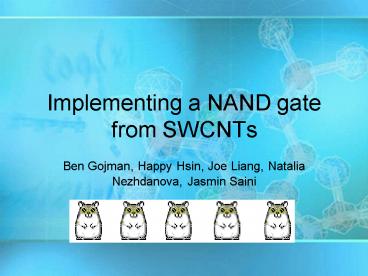Implementing a NAND gate from SWCNTs - PowerPoint PPT Presentation
1 / 38
Title:
Implementing a NAND gate from SWCNTs
Description:
A CNT about one nanometer in diameter bridges source and drain ... An anion-exchanged column could be used to separate bound tube and free tube. Metallic tubes ... – PowerPoint PPT presentation
Number of Views:99
Avg rating:3.0/5.0
Title: Implementing a NAND gate from SWCNTs
1
Implementing a NAND gate from SWCNTs
- Ben Gojman, Happy Hsin, Joe Liang, Natalia
Nezhdanova, Jasmin Saini
2
Motivation
- SWCNT Transistor
- SWCNT Inverter
3
SWCNT Field-Effect Transistor
A semiconducting carbon nanotube supported on two
electrodes can replace the silicon channel in a
field-effect transistor.
A CNT about one nanometer in diameter bridges
source and drain electrodes, and a gating voltage
applied to the silicon substrate induces carriers
onto the nanotube to turn the transistor on.
Conductance G vs. gate voltage Vg of a p-type
semiconducting SWCNT FET
4
Intramolecular Inverter
- Inverter built out of SWCNT
- Protect p-type FET part of nanotube with PMMA and
dope the exposed area to create the n-type FET
5
Experimental Results
- Vin/Vout measured
- Results indicate high gain as well as inverter
behavior
6
Y-junction CNTs
- Synthesis
- Electronic Properties
7
Fabrication of Y-Junction Carbon Nanotubes
Pyrolysis Synthesis Method Proposed by B. C.
Satishkumar, et al
240 sccm
Outlet
Thiophene
10 sccm
Yield 70
First Furnace is heated at a rate 10 degree/min
until it reaches 623K.
Second Furnace is the Pyrolysis zone (1273K)
Pyrolysis is a form of incineration that
chemically decomposes organic materials by heat
in the absence of oxygen.
The output has carbon nanotubes, and these tubes
have multiple Y junction and can be examined
with Transmission Electron Microscope (TEM).
8
Template Synthesis Method Proposed by Jingming
Xu, et al
3 . Stem 90 nm branches 50 nm in diameter
1 .forming a Y-branched nanochannel alumina
template
2. electrochemically deposited some cobalt
catalyst in the bottom of the template channels
and reduced the catalystat 600 oC for 45 hours
under a carbon monoxide flow (100 cm3/min).
Some addition Pictures
9
Mechanical Properties Carbon Nanotubes
- Small size
- Low density
- Stiff and strong
- Conduct electricity
- Conduct heat
10
Defining characteristics/properties
Two important features chirality diameter of
tube ? Determine whether metallic or
semiconducting
11
(No Transcript)
12
CNTs as nanoelectronical devices
- High mechanical strength (tensile strength 60GPa)
and modulus (Youngs modulus 1TPa) - High electrical conductivity (106 ohm-1
typically) - Exhibit ballistic transport
- High thermal conductivity (1750-5800 W/mK)
- covalently bonded and are electrical conductors
dont suffer from electromigration or atomic
diffusion and thus can carry high current
densities (107 -109 A/cm2 ) - Single wall nanotubes can be metallic or
semi-conducting - Chemically inert, not attacked by strong acids or
alkali
13
Necessary properties/attributes
- Requirements
- No rectification
- High conductance
- Low power dissipation
- Current challenges
- Fabrication
- separation
- Positioning
- Physical models
14
Electronic Structure
- Look at graphene (fused benzene)
- Bonding p-band and anti-bonding p-band form from
overlap between two Pz AOs - Expression 2-D energy states
- W2D(kx,ky)
- /-?014cos(?3kxa/2)cos(kya/2)4cos²(kya/2)½
- Density of States
- -high number in axial direction
- -limited in circumferential direction by chiral
vector Ch - Allowed (1-D quantum states) along tube axis
- Chk 2pj j0,1,2,
- ? Different allowed wave vectors (kmomentum e-)
according to CNT
15
Molecular Simulation Methods-the physics-
- Ab Initio methods
- Obtain accurate solutions to Schrodinger equation
- Not many exact solutions
- Use various approximations
- Tight binding model
- Classical molecular dynamics
- Solve Newtons 2nd law, particle dynamics
- Continuum and multiscale models
16
Physics for Y junction CNTs
- Transmission function obtained using Greens
function formalism - Using tight-binding formalism for Hamiltonian and
Greens function - From transmission function derive current
properties using Landauer and Buttiker formalism
for Quantum conductivity
17
Y junction results
Current through nanotube i
Nonlinear conductance matrix normalized to e2/h
reads
18
Symmetric Y-junction
19
(No Transcript)
20
...and now, our Feature Presentation
21
NAND gate proposal
Au microwires
VDD
B
A
Vout
A
B
22
(No Transcript)
23
(No Transcript)
24
(No Transcript)
25
(No Transcript)
26
(No Transcript)
27
(No Transcript)
28
(No Transcript)
29
(No Transcript)
30
(No Transcript)
31
250nm
32
Future Directions
- DNA Self-Assembly
33
DNA-Assisted Disperion and Separation of Carbon
Nanotubes
WHY DNA-Assisted?
- Carbon nanotubes are polydispersive and possess
poor solubility in aqueous solution and
non-aqueous solution. - It is discovered that DNA(ssDNA) binding to
nanotubes is EFFECTIVE and FACILE. - DNA-coated nanotubes are stable for months at
room temperature - Free DNA can be removed by using anion-exchange
chromatography without disturbing the bound tube
(strong binding).
polyT sequence
34
How DNA-Assisted?
- ssDNA molecule are flexible within the
sugar-phosphate backbone therefore, the molecule
can find the low-energy conformations that
maximize base-nanotube stacking interactions
while exposing the sugar-P groups to water. - Some thermodynamics simulations were done to show
that the binding of ssDNA onto tubes can compete
effectively with nanotubes clinging to each other
to form ropes. - Binding allows the backbone to be solvated by
solvent and thus reduce the surface tension. - DNA is charged molecule and thus changes the
charge of the bound tube. An anion-exchanged
column could be used to separate bound tube and
free tube.
Metallic tubes
Semi-conducting
35
References
- Y-Junction Carbon nanotuebe, B. C. Satishkumar,
P. J. Thomas, A. Govindraj, and C. N. R. Rao,
Appl.Phys. Lett. 77, 2530 2000 - Ballistic switching and rectification in single
wall carbon nanotube Y junctions, Antonis N.
Andriotis, APPLIED PHYSICS LETTERS VOLUME 79,
NUMBER 2 - Sticking of Carbon Nanotube Y Junction Branches,
L. A. Chernozatonskii and I. V. Ponomareva, JETP
letter, Vol.78, No.5, 2003, pp. 327-331 - Growing Y-junction carbon nanotube, J. Li, C.
Papadopoulos, and J. Xu, Nature London! 402, 253
1999!.
36
Acknowledgements
- Prof. Marc Bockrath
- Prof. Erik Winfree
37
Questions?
JOE
38
Have a Great Summer!!!































